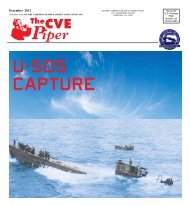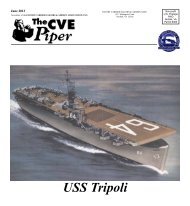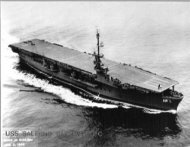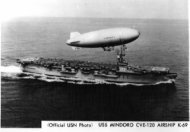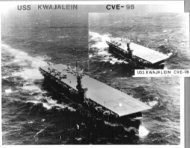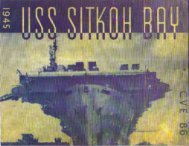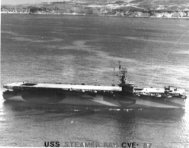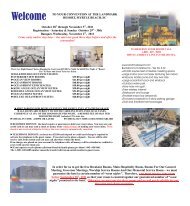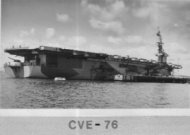USS Bismarck Sea - Escort Carriers.com
USS Bismarck Sea - Escort Carriers.com
USS Bismarck Sea - Escort Carriers.com
You also want an ePaper? Increase the reach of your titles
YUMPU automatically turns print PDFs into web optimized ePapers that Google loves.
Return to DANFS Index Return to Naval Historical Center homepage<br />
<strong>Bismarck</strong> <strong>Sea</strong><br />
DEPARTMENT OF THE NAVY -- NAVAL HISTORICAL CENTER<br />
805 KIDDER BREESE SE -- WASHINGTON NAVY YARD<br />
WASHINGTON DC 20374-5060<br />
A body of water located northeast of New Guinea. It was the scene of an Allied naval<br />
victory during World War II. On 28 February 1943, in an attempt to augment their forces<br />
on Papua, a Japanese convoy consisting of eight transports and eight destroyers departed<br />
Rabaul. Foul weather could not hide the convoy for long; and, on 1 March, one of Lt.<br />
Gen George C. Kenney's planes sighted it and began tracking it. By noon of 2 March, the<br />
Allies had attacked, sinking one transport and damaging two others. On 3 March, Allied<br />
bombers and PT boats demolished most of the remaining ships. From the entire convoy,<br />
only four destroyers escaped.<br />
(CVE 95: dp. 7,800; l. 512'3"; b. 65'2"; ew. 108'1"; dr. 22'6"; s. 19.3 k.; cpl. 860; a. 1 5",<br />
16 40mm.; ac. 27; cl. Casablanca)<br />
Alikula Bay (CVE 95) was laid down on 31 January 1944 at Vancouver, Wash., by the<br />
Kaiser Shipbuilding Co. under a Maritime Commission contract (MC hull 1132);<br />
launched on 17 April 1944; sponsored by Mrs. Mon C. Wallgren; renamed <strong>Bismarck</strong> <strong>Sea</strong><br />
on 16 May 1944; transferred to the Navy on 20 May 1944 at Astoria, Oreg.; and<br />
<strong>com</strong>missioned the same day, Capt. John L. Pratt in <strong>com</strong>mand.<br />
Following shakedown off the west coast in June, the escort carrier departed San Pedro,<br />
Calif., on 1 July with airplanes and pilots bound for Hawaii. After unloading at Pearl<br />
Harbor, <strong>Bismarck</strong> <strong>Sea</strong> continued westward to the Marshalls. She arrived at Majuro Atoll<br />
on 16 July, unloaded new planes and loaded damaged ones before steaming back to Pearl<br />
Harbor in <strong>com</strong>pany with Saginaw Bay (CVE 82). The two escort carriers arrived on 29<br />
July; and, by early August, she was on her way back to San Diego for a four-week<br />
overhaul.<br />
On 7 September, <strong>Bismarck</strong> <strong>Sea</strong> began flight operations and training o£f the California<br />
coast. This employment ended on 16 October when she sailed for Pearl Harbor. After a<br />
brief stop at Oahu, the escort carrier proceeded westward to Eniwetok where she reported<br />
for duty with the 7th Pleet on 1 November.<br />
Ordered to Ulithi the next day, <strong>Bismarck</strong> <strong>Sea</strong> remained there for 10 days before being
sent to Philippine waters to cover convoy movements east of Mindanao. There, on 21<br />
November, a Japanese plane made a strafing run on the carrier without inflicting any<br />
damage and escaped to the northwest before her guns could bear effectively. <strong>Bismarck</strong><br />
<strong>Sea</strong> then received orders to Manus in the Admiralty Islands to join Task Group (TG)<br />
77.4. The ship anchored at Seeadler Harbor on 27 November and, during the ensuing<br />
month, conducted frequent flight exercises and gunnery practices east of Huon Gulf, New<br />
Guinea. Tasked with air support for the 6th Army's landing at Lingayen Gulf, TG 77.4<br />
sailed for the Palaus on 27 December on the first leg of its approach for the invasion of<br />
Luzon.<br />
On 4 January 1945, the task group suffered intermittent attacks by Japanese land-based<br />
airpower. The only enemy surface forces encountered were the destroyers Hinoki and<br />
Sugi that her lookouts sighted on 5 January near Luzon. <strong>Bismarck</strong> <strong>Sea</strong> sent out four<br />
torpedo planes and four fighters to join other naval air units in a strike on the two enemy<br />
warships. Together, they seriously damaged both destroyers. Although subjected to many<br />
enemy air attacks, one of which claimed Ommaney Bay (CVE 79) and wreaked other less<br />
fatal damage, TG 77.4 arrived off Luzon and launched daily support and search missions<br />
from dawn to dusk until 17 January when the task group headed for the Carolines.<br />
At Ulithi, preparations for the assault and occupation of Iwo Jima were underway. Once<br />
again, <strong>Bismarck</strong> <strong>Sea</strong> operated as part of the escort carrier support force. The so called<br />
"baby flattops" o£ TG 52.2 departed Ulithi on 10 February, moved toward Iwo Jima, and<br />
arrived on station on 16 February. <strong>Bismarck</strong> <strong>Sea</strong> operated about 50 miles south of the<br />
island providing antiaircraft and antisubmarine patrols for the battleships, cruisers, and<br />
destroyers engaged in bombardment. At O900 on 19 February, the first assault wave<br />
landed. The escort carriers then supplied observation and spotting planes, photographic<br />
flights, <strong>com</strong>bat air patrol over the beaches, antisubmarine patrols, and strike missions for<br />
direct support of the troops.<br />
On the evening of 21 February, <strong>Bismarck</strong> <strong>Sea</strong> had just recovered her aircraft from a strike<br />
when a swarm of Japanese planes appeared. The escort carrier splashed one bomber, but<br />
another one crashed into the ship abeam of the after elevator. The crash knocked four<br />
torpedoes on to the hangar deck, parted the elevator cables, and damaged the after fire<br />
main. The fire appeared controllable until its glow attracted a second Japanese plane<br />
which also crashed her just forward of the elevator well, killing or mortally wounding the<br />
entire fire-fighting party. This explosion buckled bulkheads and collapsed the decks in<br />
the ammunition clipping rooms, adding fuel to the fire. The planes on the hangar deck<br />
added gasoline to the holocaust. Soon, the flames raged out of control and a variety of<br />
ordnance began to explode, so the captain ordered <strong>Bismarck</strong> <strong>Sea</strong> abandoned. In less than<br />
30 minutes, her entire crew made it into the water. After many explosions and two hours<br />
of burning, the ship rolled over and sank.<br />
Rough seas, cold water, and Japanese strafing cost the lives of many members of the<br />
escort carrier's crew. Three destroyers and three destroyer escorts spent 12 hours picking<br />
up survivors, but 318 gallant sailors were lost. The survivors were sent to transports just
off Iwo Jima and were able to see the American flag finally raised on Mount Suribachi.<br />
Her name was struck form the Navy list on 30 March 1945.<br />
<strong>Bismarck</strong> <strong>Sea</strong> earned three battle stars for her service during World War II.



